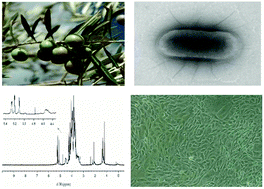当前位置:
X-MOL 学术
›
Food Funct.
›
论文详情
Our official English website, www.x-mol.net, welcomes your
feedback! (Note: you will need to create a separate account there.)
Exopolysaccharides from olive brines could reduce the adhesion of ETEC K88 to intestinal epithelial cells†
Food & Function ( IF 5.1 ) Pub Date : 2018-06-12 00:00:00 , DOI: 10.1039/c8fo00690c Yanan Zhu 1, 2, 3, 4, 5 , Gemma González-Ortiz 1, 2, 3, 4, 5 , Rufino Jiménez-Díaz 5, 6, 7, 8 , Míriam Pérez-Trujillo 3, 4, 5, 9 , Teodor Parella 3, 4, 5, 9 , Paola López-Colom 1, 2, 3, 4, 5 , Susana María Martín-Orúe 1, 2, 3, 4, 5
Food & Function ( IF 5.1 ) Pub Date : 2018-06-12 00:00:00 , DOI: 10.1039/c8fo00690c Yanan Zhu 1, 2, 3, 4, 5 , Gemma González-Ortiz 1, 2, 3, 4, 5 , Rufino Jiménez-Díaz 5, 6, 7, 8 , Míriam Pérez-Trujillo 3, 4, 5, 9 , Teodor Parella 3, 4, 5, 9 , Paola López-Colom 1, 2, 3, 4, 5 , Susana María Martín-Orúe 1, 2, 3, 4, 5
Affiliation

|
This study aims to explore the biological functions of the isolated exopolysaccharides (EPSs) produced during the industrial fermentation of olives against enterotoxigenic E. coli (ETEC) K88. Exopolysaccharides were isolated from five industrial fermenters. Analysis of their monosaccharide composition by GLC revealed that the main components were glucose (27%–50%) and galactose (23%–33%) followed by rhamnose (4–23%) and arabinose (6–17%). The 1H NMR spectrum showed a very similar profile between samples, and a more in-depth analysis revealed the presence of an α-pyranose in the form of α-D-Glcp-(1→) and two different α-furanoses, with chemicals shift values, suggesting the presence of α-D-Glcf and α-D-Galf. Miniaturized in vitro tests demonstrated the ability of EPS samples to attach specifically to ETEC K88 (P < 0.05) with variable intensities. The competition test did not show the ability to block the ETEC K88 adhesion to IPEC-J2 cells; however, in the displacement test, all EPS samples were shown to effectively remove the pathogens attached to the cells (P < 0.01). These results suggest that the EPSs produced during the fermentation of table green olives could interfere with the attachment of opportunistic pathogens onto the intestinal epithelial cells. This would open the possibility of novel functional properties for this traditional Mediterranean fermented food and for the isolated EPSs as candidates for nutraceutics to be used in human and/or animal diets in the prevention and treatment of ETEC diarrhoea.
中文翻译:

橄榄盐水中的胞外多糖可能会降低ETEC K88与肠上皮细胞的粘附力†
这项研究的目的是探索橄榄在工业发酵过程中针对肠毒素大肠杆菌(ETEC)K88产生的分离的胞外多糖(EPS)的生物学功能。从五个工业发酵罐中分离出胞外多糖。通过GLC对它们的单糖成分进行分析后发现,主要成分为葡萄糖(27%–50%)和半乳糖(23%–33%),其次是鼠李糖(4–23%)和阿拉伯糖(6–17%)。的1个H NMR谱显示出非常相似的轮廓的样品之间,和更深入的分析显示形式的α-吡喃糖的存在下α- d -Glc p - (1→)和两种不同的α-呋喃糖,具有化学位移值,表明存在α- D -Glc f和α- D -Gal f。小型化的体外测试表明,EPS样品能够以可变的强度特异性附着在ETEC K88上(P <0.05)。竞争测试未显示出阻止ETEC K88粘附至IPEC-J2细胞的能力。然而,在置换试验中,所有EPS样品均显示可有效去除附着在细胞上的病原体(P<0.01)。这些结果表明,食用绿橄榄发酵过程中产生的EPS可能会干扰机会性病原体附着在肠上皮细胞上。这将为这种传统的地中海发酵食品和分离的EPS用作人类和/或动物饮食中预防和治疗ETEC腹泻的营养食品候选者提供新颖功能特性的可能性提供了可能性。
更新日期:2018-06-12
中文翻译:

橄榄盐水中的胞外多糖可能会降低ETEC K88与肠上皮细胞的粘附力†
这项研究的目的是探索橄榄在工业发酵过程中针对肠毒素大肠杆菌(ETEC)K88产生的分离的胞外多糖(EPS)的生物学功能。从五个工业发酵罐中分离出胞外多糖。通过GLC对它们的单糖成分进行分析后发现,主要成分为葡萄糖(27%–50%)和半乳糖(23%–33%),其次是鼠李糖(4–23%)和阿拉伯糖(6–17%)。的1个H NMR谱显示出非常相似的轮廓的样品之间,和更深入的分析显示形式的α-吡喃糖的存在下α- d -Glc p - (1→)和两种不同的α-呋喃糖,具有化学位移值,表明存在α- D -Glc f和α- D -Gal f。小型化的体外测试表明,EPS样品能够以可变的强度特异性附着在ETEC K88上(P <0.05)。竞争测试未显示出阻止ETEC K88粘附至IPEC-J2细胞的能力。然而,在置换试验中,所有EPS样品均显示可有效去除附着在细胞上的病原体(P<0.01)。这些结果表明,食用绿橄榄发酵过程中产生的EPS可能会干扰机会性病原体附着在肠上皮细胞上。这将为这种传统的地中海发酵食品和分离的EPS用作人类和/或动物饮食中预防和治疗ETEC腹泻的营养食品候选者提供新颖功能特性的可能性提供了可能性。











































 京公网安备 11010802027423号
京公网安备 11010802027423号